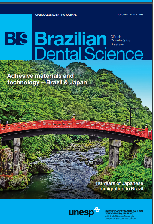Changes in dental esthetic perceptions of patients subjected to in-office tooth bleaching
DOI:
https://doi.org/10.14295/bds.2018.v21i2.1559Abstract
Objective: This study evaluated changes in the esthetic perceptions of patients subjected to in-office tooth bleaching. Material and Methods: Fifty participants included in a clinical trial evaluating the in-office tooth bleaching answered two questionnaires about their dental esthetic perceptions. The participants answered the Orofacial Esthetic Scale (OES) questionnaire and the Psychosocial Impact of Dental Aesthetics Questionnaire (PIDAQ) before and after treatment. The average scores observed at baseline were compared with those recorded after tooth bleaching using the paired t-test or the Wilcoxon signed rank test (? = 0.05). Results: Improvement in tooth color (reduction of 5.1 shade guide units) had a positive impact on patients’ perceptions. According to PIDAQ, tooth bleaching significantly increased the psychological impact and dental self-confidence; and reduced esthetic concerns. The OES demonstrated improvements in participants’ satisfaction for all questions, except for the one on “facial appearance”. However, higher effect size was observed for the question related to tooth color, as expected. Conclusion: Tooth bleaching was associated with an overall improvement in dental esthetic perception, even when only tooth color was affected.
Keywords
Patient-reported outcomes; Randomized Controlled Clinical Trials; Tooth Bleaching.
Downloads
Downloads
Additional Files
Published
How to Cite
Issue
Section
License
Brazilian Dental Science uses the Creative Commons (CC-BY 4.0) license, thus preserving the integrity of articles in an open access environment. The journal allows the author to retain publishing rights without restrictions.
=================




























